 W
WThe Ahiram sarcophagus was the sarcophagus of a Phoenician King of Byblos, discovered in 1923 by the French excavator Pierre Montet in tomb V of the royal necropolis of Byblos.
 W
WThe Anat Athena bilingual is a bilingual Greek-Phoenician inscription on a rock-cut stone found in the outskirts of the village of Larnakas tis Lapithou, Cyprus. It was discovered just above the village, at the foot of a conical agger, 6m high and 40 meters in circumference. It was originally found in c.1850.
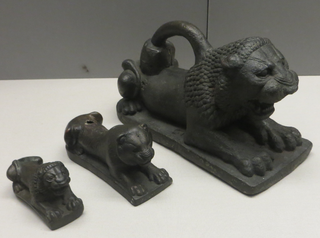 W
WThe Assyrian lion weights are a group of sixteen bronze Mesopotamian weights from the 8th century BCE, with bilingual inscriptions in both cuneiform and Phoenician characters; the latter inscriptions are known as CIS II 1-14. The lion weights were discovered at Nimrud in the late 1840s and are now in the British Museum.
 W
WThe Avignon Punic inscription is a Punic language inscription found in the Quartier Ouest of Avignon in 1897, by a builder digging a trench 2-3 meters deep on the boundary of a property. It was first announced by fr: Mayer Lambert.
 W
WThe Baalshillem Temple Boy, or Ba'al Sillem Temple Boy, is a votive statue of a "temple boy" with a Phoenician inscription known as KAI 281. It was found along with a number of other votive statues of children near the canal in the Temple of Eshmun in 1963-64 by Maurice Dunand, and is currently in the National Museum of Beirut. The inscription mentions four previously unknown names of Kings of Sidon, which correspond exactly with those from known Sidonian coins. The inscription has been translated as follows:This statue that Baalshillem, son of King Ba'na, king of the Sidonians, son of King Abdamun, king of the Sidonians, son of King Baalshillem, king of the Sidonians, gave to his lord Eshmun at the "Ydll"-Spring. May he bless him.
 W
WThe Byblian royal inscriptions are five inscriptions from Byblos written in an early type of Phoenician script, all of which were discovered in the early 20th century.
 W
WThe Byblos Necropolis graffito is a Phoenician inscription situated in the royal necropolis of Byblos.
 W
WThe Canaanite and Aramaic inscriptions, also known as Northwest Semitic inscriptions, are the primary extra-Biblical source for understanding of the society and history of the ancient Phoenicians, Hebrews and Arameans. Semitic inscriptions may occur on stone slabs, pottery ostraca, ornaments, and range from simple names to full texts. The older inscriptions form a Canaanite–Aramaic dialect continuum, exemplified by writings which scholars have struggled to fit into either category, such as the Stele of Zakkur and the Deir Alla Inscription.
 W
WThe Carchemish Phoenician inscription is a 5th-century BCE Phoenician inscription on glazed faience tile in Carchemish in the early 1950s during the excavations of Richard David Barnett and Leonard Woolley for the British Museum. It measured 9 x 4 cm, and was found in northwest end of the "Acropolis Mount" in the northeast corner of the Carchemish mound.
 W
WThe Carpentras Stele is a stele found at Carpentras in southern France in 1704 that contains the first published inscription written in the Phoenician alphabet. It remains in Carpentras, at the Bibliothèque Inguimbertine, in a "dark corner" on the first floor. It is known as KAI 269 and CIS II 141.
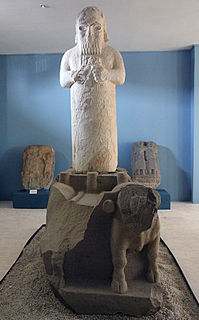 W
WThe Çineköy inscription is an ancient bilingual inscription, written in Hieroglyphic Luwian and Phoenician languages. The inscription is dated to the second half of the 8th century BCE. It was uncovered in 1997 near the village of Çine, that is located some 30 km south of Adana, capital city of the Adana Province in southern Turkey.
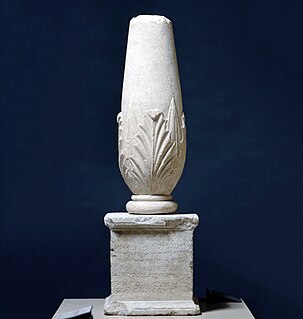 W
WThe Cippi of Melqart is the collective name for two Phoenician marble cippi that were unearthed in Malta under undocumented circumstances and dated to the 2nd century BC. These are votive offerings to the god Melqart, and are inscribed in two languages, Ancient Greek and Phoenician, and in the two corresponding scripts, the Greek and the Phoenician alphabet. They were discovered in the late 17th century, and the identification of their inscription in a letter dated 1694 made them the first Phoenician writing to be identified and published in modern times. Because they present essentially the same text, the cippi provided the key to the modern understanding of the Phoenician language. In 1758, the French scholar Jean-Jacques Barthélémy relied on their inscription, which used 17 of the 22 letters of the Phoenician alphabet, to decipher the unknown language.
 W
WThe Corpus Inscriptionum Semiticarum is a collection of ancient inscriptions in Semitic languages produced since the end of 2nd millennium BC until the rise of Islam. It was published in Latin. In a note recovered after his death, Ernest Renan stated that: "Of all I have done, it is the Corpus I like the most."
 W
WThe Deir 'Alla Inscription, known as KAI 312, was discovered during a 1967 excavation in Deir 'Alla, Jordan. It is currently at the Jordan Archaeological Museum.
 W
WThe Ekron Royal Dedicatory Inscription, or simply the Ekron inscription, is a royal dedication inscription found in its primary context in the ruins of a temple during the 1996 excavations of Ekron. It is known as KAI 286.
 W
WThe Eshmunazar II sarcophagus is a 6th-century BC sarcophagus unearthed in 1855 in the "Phoenician Necropolis", a hypogeum complex in the southern area of the city of Sidon in modern-day Lebanon. The sarcophagus was discovered by members of the French consulate in Sidon and was donated to the Louvre. The Eshmunazar II sarcophagus has two sets of Phoenician inscriptions, one on its lid and the other on its trough, under the sarcophagus head. The lid engraving was of great significance upon its discovery; it was the first Phoenician language inscription to be discovered in Phoenicia proper, the most detailed Phoenician text ever found anywhere up to that point, and is the second longest extant Phoenician inscription after the one discovered at Karatepe.
 W
WThe Gozo stele is a Phoenician language inscription found near Gozo, Malta in 1855. It is currently in the Gozo Museum of Archaeology.
 W
WThe Honeyman inscription, also known as the Archaic Cyprus inscription, is a seven-line Phoenician gravestone inscription found in Cyprus and first published in 1939. It is the oldest detailed Phoenician inscription found in Cyprus.
 W
WThe Idalion bilingual is a bilingual Cypriot-Phoenician inscription found in 1869 in Dali, Cyprus. It was the key to the decipherment of the Cypriot syllabary, in the manner of the Rosetta Stone to hieroglyphs. The discovery of the inscription was first announced by Paul Schröder in May 1872. It is dated to 388 BCE. The Phoenician inscription is known as KAI 38 and CIS I 89.
 W
WThe Idalion Temple inscriptions are six Phoenician inscriptions found by Robert Hamilton Lang in his excavations at the Temple of Idalium in 1869, whose work there had been inspired by the discovery of the Idalion Tablet in 1850. The most famous of these inscriptions is known as the Idalion bilingual. The Phoenician inscription is known as KAI 38-40 and CIS I 89-94.
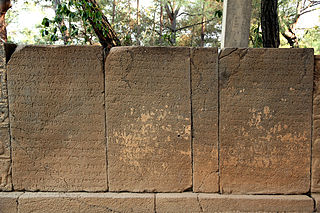 W
WThe Karatepe bilingual, also known as the Azatiwada inscription, is a bilingual inscription on stone slabs consisting of Phoenician and Luwian text each, which enabled the decryption of the Anatolian hieroglyphs. The artifacts were discovered at Karatepe, southern Turkey by the archaeologists Helmuth Theodor Bossert (1889–1961) and Halet Çambel (1916–2014) in 1946.
 W
WThe Kellia inscription is a Phoenician inscription found in the church of St Anthony in Kellia, Cyprus by Ludwig Ross in 1844. It is a funerary inscription of a noblewoman, the daughter of a Shophet. It is 1 foot wide and 2 and 3/4 feet high.
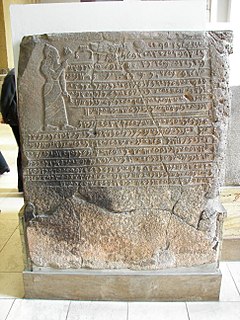 W
WThe Kilamuwa Stele is a 9th-century BC stele of King Kilamuwa, from the Kingdom of Bit-Gabbari. He claims to have succeeded where his ancestors had failed, in providing for his kingdom. The inscription is known as KAI 24.
 W
WThe Kition Necropolis Phoenician inscriptions are four Phoenician inscriptions discovered in the necropolis of Tourapi at Kition in 1894 by British archaeologist John Myres on behalf of the Cyprus Exploration Fund. They currently reside in the British Museum, the Cyprus Museum and the Ashmolean Museum.
 W
WThe Kition Tariffs are two important Phoenician inscriptions found near Larnaka, Cyprus in 1879. They have been described as "Among the longest and most important Phoenician inscriptions from Cyprus".
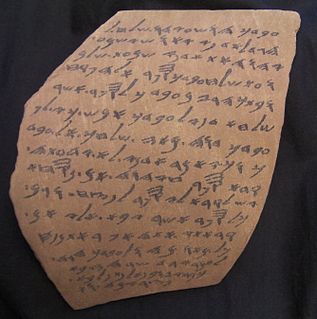 W
WThe Lachish Letters or Lachish Ostraca, sometimes called Hoshaiah Letters, are a series of letters written in carbon ink containing Canaanite inscriptions in Ancient Hebrew on clay ostraca. The letters were discovered at the excavations at Lachish.
 W
WThe Lazare Costa inscriptions are a group of Punic inscriptions found in Constantine, Algeria between 1875 and 1880 by Lazare Costa, a Constantine-based Italian antiquarian. Most of the steles are now in the Louvre.
 W
WThe Lilybaeum stele is a notable Phoenician gravestone stele found in Sicily and first published in 1882.
 W
WThe Marseille Tariff is a Punic language inscription from the third century BCE, found on two fragments of a stone in 1844/45 at Marseille in Southern France. It is thought to have originally come from the temple of Baal-Saphon in Carthage. It is one of the earliest published inscriptions written in the Phoenician alphabet, and one of the longest ever found.
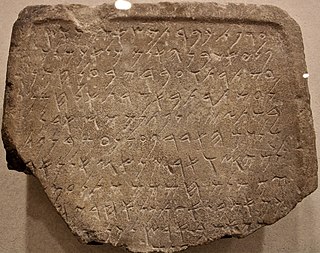 W
WThe Masub inscription is a Phoenician inscription found at Khirbet Ma'sub near the Palestinian village of Al-Bassa. It is also known as KAI 19.
 W
WThe Mdina steles are two Phoenician language inscriptions found near the city of Mdina, Malta, in 1816. The findspot is disputed; the oldest known description places it near the Tal-Virtù Church. The surviving stele is currently in the National Museum of Archaeology, Malta; the other stele has been considered lost for more than a century.
 W
WThe Nora Stone or Nora Inscription is an ancient Phoenician inscription found at Nora on the south coast of Sardinia in 1773. Though its precise finding place has been forgotten, it has been dated by palaeographic methods to the late 9th century to early 8th century BCE and is still considered the oldest Phoenician inscription yet found in Sardinia. It is conserved at the Museo archeologico nazionale, Cagliari. The inscription is known as KAI 46.
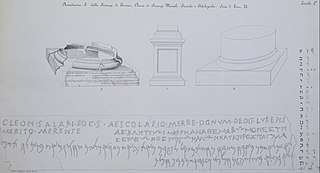 W
WThe Pauli Gerrei trilingual inscription is a trilingual Greek-Latin-Phoenician inscription on the base of a bronze column found in San Nicolò Gerrei in Sardinia in 1861. The stele was discovered by a notary named Michele Cappai, on the right side of the Strada statale 387 del Gerrei that descends towards Ballao.
 W
WPhoenician is an extinct Canaanite Semitic language originally spoken in the region surrounding the cities of Tyre and Sidon. Extensive Tyro-Sidonian trade and commercial dominance led to Phoenician becoming a lingua-franca of the maritime Mediterranean during the Iron Age. The Phoenician alphabet was spread to Greece during this period, where it became the source of all modern European scripts.
 W
WThe Pococke Kition inscriptions were a group of 31 Phoenician and 2 non-Phoenician inscriptions found in Cyprus and published by Richard Pococke in 1745. In describing Kition, Pococke wrote: "the walls seem to have been very strong, and in the foundations there have been found many stones, with inscriptions on them, in an unintelligible character, which I suppose, is the antient [sic] Phoenician..."
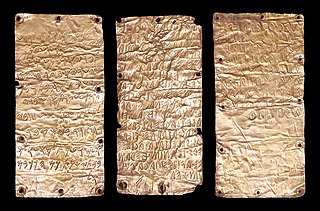 W
WThe Pyrgi Tablets are three golden plates inscribed with a bilingual Phoenician–Etruscan dedicatory text. They were discovered in 1964 during a series of excavations at the site of ancient Pyrgi, on the Tyrrhenian coast of Italy in Latium (Lazio). The text records the foundation of a temple and its dedication to the Etruscan supreme goddess Uni, who is identified with Astarte in the Phoenician text. The temple's construction is attributed to Tiberius Velianas, ruler of the nearby city of Caere.
 W
WThe Samaria Ostraca are 102 ostraca found in 1910 in excavations in Sebastia, Nablus led by George Andrew Reisner of the Harvard Semitic Museum. Of the 102, only 63 are legible. The ostraca are written in the paleo-Hebrew alphabet, which very closely resemble those of the Siloam Inscription, but show a slight development of the cursive script. The primary inscriptions are known as KAI 183–188.
 W
WThe Sant'Antioco bilingual is a bilingual Latin-Punic inscription found in 1881 in Sant'Antioco, Sardinia. The inscription is on a large marble block 71 x 63 cm, with a hole at the top for a statue.
 W
WThe Tabnit sarcophagus is the sarcophagus of the Phoenician King of Sidon Tabnit I, the father of King Eshmunazar II. The sarcophagus is decorated with two separate and unrelated inscriptions – one in Egyptian hieroglyphics and one in Phoenician script. The latter contains a curse for those who open the tomb, promising impotency and loss of an afterlife. It was created in the early 5th century BC, and was unearthed in 1887 by Osman Hamdi Bey at the Ayaa Necropolis east of Sidon together with the Alexander Sarcophagus and other related sarcophagi. Tabnit's body was found floating perfectly preserved in the original embalming fluid. Both the sarcophagus and Tabnit's decomposed skeleton are now in the Istanbul Archaeology Museums.
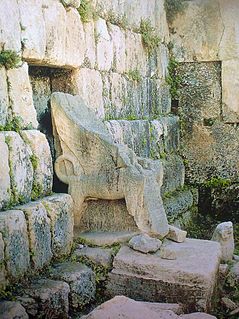 W
WThe Temple of Eshmun is an ancient place of worship dedicated to Eshmun, the Phoenician god of healing. It is located near the Awali river, 2 kilometres (1.2 mi) northeast of Sidon in southwestern Lebanon. The site was occupied from the 7th century BC to the 8th century AD, suggesting an integrated relationship with the nearby city of Sidon. Although originally constructed by Sidonian king Eshmunazar II in the Achaemenid era to celebrate the city's recovered wealth and stature, the temple complex was greatly expanded by Bodashtart, Yatan-milk and later monarchs. Because the continued expansion spanned many centuries of alternating independence and foreign hegemony, the sanctuary features a wealth of different architectural and decorative styles and influences.
 W
WThe Ur Box inscription is a 7th century BCE Phoenician inscription on the lid of an ivory box found in Ur in 1927 during the excavations of Leonard Woolley. It was the first Phoenician inscription found in Iraq.
 W
WThe Yehawmilk stele, de Clercq stele, or Byblos stele, also known as KAI 10 and CIS I 1, is a Phoenician inscription from c.450 BC found in Byblos at the end of Ernest Renan's Mission de Phénicie. Yehawmilk, king of Byblos, dedicated the stele to the city’s protective goddess Ba'alat Gebal.
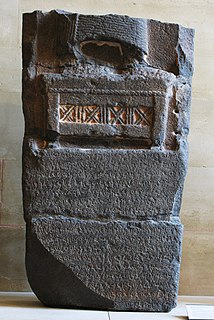 W
WThe Stele of Zakkur is a royal stele of King Zakkur of Hamath and Luhuti in the province Nuhašše of Syria, who ruled around 785 BC.